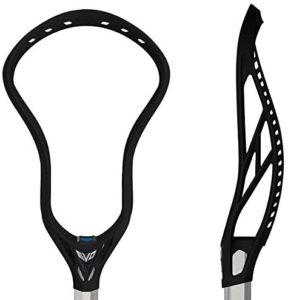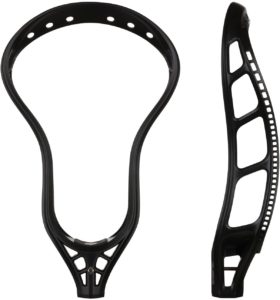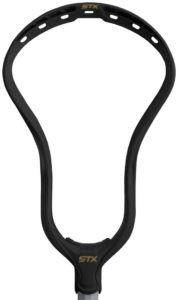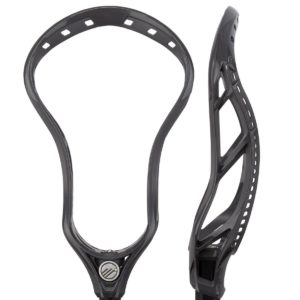Midfielders, or “middies,” are players with versatile skill sets who need a versatile head that can match their many different responsibilities on the field. Some of these responsibilities include: clearing the ball from defense to offense; playing offense and defense across the length of the field; fighting for ground balls; passing and shooting from both short and long range; and sometimes taking faceoffs. The top lacrosse heads for midfielders can enhance a player’s abilities in these areas.
- TLDR: Which lacrosse head should I get?
- All around middies: Warrior Evo 5
- Stringing enthusiasts: StringKing Mark 2V
- Defensive middies and LSMs: STX Stallion Omega
- Stickhandlers and playmakers: Maverik Tactik 2.0
- Snipers and faceoff middies: Nike CEO 2
This guide is primarily intended to be for advanced lacrosse players. If you are looking for more basic information about lacrosse heads or the midfielder position, check out our other guides on those topics:
Overview of lacrosse heads
Beginner’s complete lacrosse stick guide
Overview of lacrosse positions
Table of Contents
What Should Middies Look for in a Head?
Because middies are a diverse bunch, there’s lots of different head options to choose from: some may be preferred by offensive players, others by defensive players; some might be best suited for shooters, others for passers and playmakers. Below are some variables to keep in mind when choosing a head that feels right for you.
But don’t overthink it too much–you really can’t go wrong with any of these heads!
Weight
Generally speaking, lighter heads are preferable for most offensive middies, since it can improve the quickness of movements when dodging with the ball, as well as quickness of release on passes and shots.
Stiffness and strength
Stiffness is usually a matter of personal preference, but many elite midfielder heads are made stiff (as opposed to flexible) so that they are less prone to warping in shape over time, which could throw off the accuracy or consistency of a player’s passing and shooting.
In addition to this added durability, stiffness adds some strength to a head, which is good for middies, who take and receive lots of stick checks during the course of a game. However, with stiffness and strength often comes a trade-off in weight: generally speaking, with added toughness comes added weight.
Stringing
Lacrosse heads have a variable amount of sidewall holes, meaning some allow for more creativity and specificity in shape and style of pocket. Each head also has an optimal release point which to some extent determines the ideal placement for a pocket (low, mid, or high) on that specific head.
Elite middie heads are usually designed for mid or low-mid pockets. Lower pockets are usually preferred by offensive players, since they help to keep the ball in the stick while running and dodging, whereas defensive middies usually like having slightly higher pockets, which helps to release the ball more quickly, enabling quicker passes and harder shots.
Scoop design
The design of a head’s scoop can affect two main components of gameplay on the field: ground ball pickups and catching the ball. A wider scoop provides a larger surface, and therefore wider margin of error, for picking up groundballs and catching passes. A narrower scoop may help to shave off a bit of weight on the head and may help a bit with accuracy in passing and shooting, but will make it harder to catch passes and pick up groundballs.
Face shape
Similar to scoop design, a narrow or “tight” face shape adds “pinch” to the head, meaning there is less room between the two sidewalls for the ball to move around. This is useful for offensive middies who do a lot of dodges and take a lot of faceoffs.
Throat design
Manufacturers sometimes try to provide lacrosse midfielders with extra ball control by manipulating the design of the throat on a lacrosse head. Some heads have an “offset” throat that makes the head essentially “lean” back behind the plane of the stick, allowing gravity to help keep the ball in the pocket. Additionally, shortening the length of the throat means the ball will rest closer to the player’s hands, which is good for quick dodges and quick passes in tight spaces.
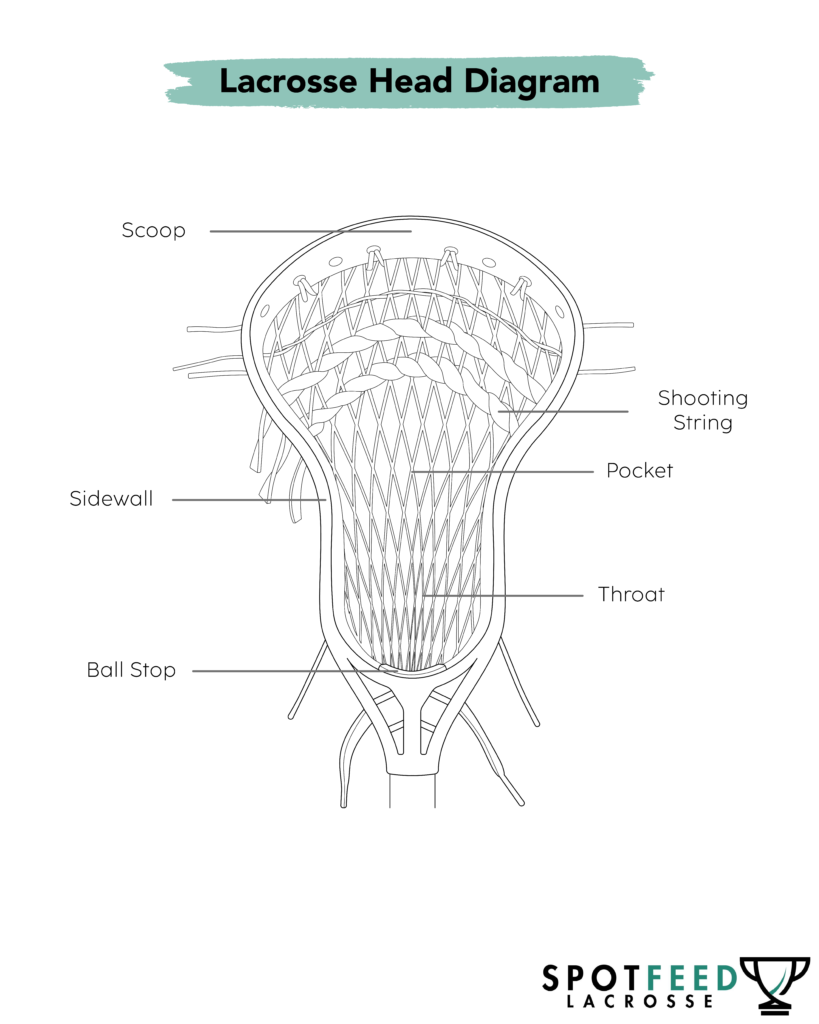
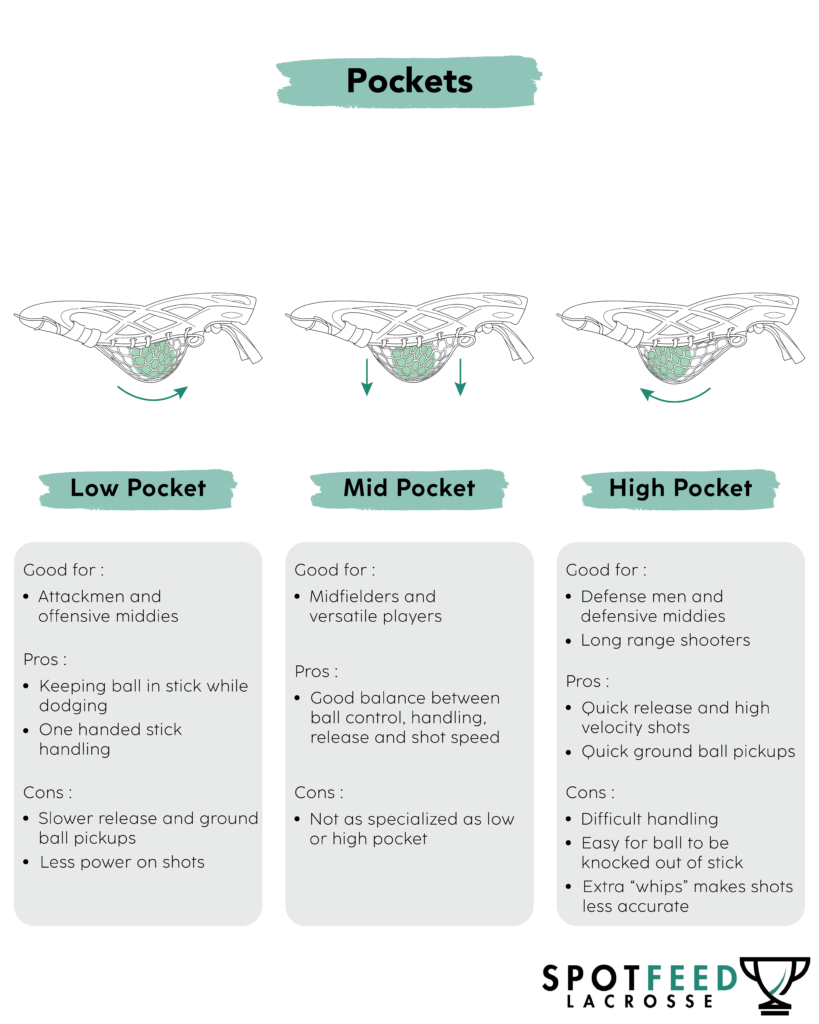
Best Lacrosse Heads for Midfielders
Warrior Evo 5
Pros
- Streamlined side rail design decreases weight
- “Tilt Tech” sidewall holes keep strings anchored snugly
- “Loc-Throat” feature helps eliminate stick rattle
- Legal for all levels of play
Cons
- Angled sidewall holes can be tough to string
- Only compatible with hollow shafts due to "Loc-Throat"
Warrior is constantly trying to strike the perfect balance between weight and toughness in their heads.
This is an especially nice focus to have for middie lacrosse heads, since the average lacrosse midfielder will find himself looking for light weight in some situations–running and dodging with the ball–and some extra weight in others–dishing out and taking stick checks. The Warrior Evo 5 satisfies this by having relatively thin side rails, bringing down overall weight without compromising on weight and strength in other parts of the head like the scoop or throat.
The side rails on this lacrosse head are optimized for a mid-to-low pocket, which also suits the desired versatility of a lacrosse midfielder looking to balance shot power with accuracy and ball control. The slightly wider head design and the rounded scoop will also make catching passes and scooping up ground balls a bit easier.
The sidewalls themselves feature unique “Tilt Tech” stringing holes, which are slightly slanted. The advantage of this is that it keeps the knots anchored in well so that the shape of the pocket lasts better over time. However, the odd design, coupled with the thinness of the sidewall makes stringing on this head a bit challenging, so it’s probably best suited for players with a lot of experience stringing their own heads.
The other patented technological feature on this head is Warrior’s “Loc-Throat,” designed to provide a better, snugger fit between head and shaft, cutting down on stick rattle issues. However, keep in mind that means this head may not be compatible with shafts that aren’t hollow.
This is one of the best middie lacrosse heads for balanced play. It’s a great all-around head that may not excel in any one particular aspect, but is a solid option at a great price point for any lacrosse midfielder.
Buying Options
StringKing Mark 2V
Pros
- Good balance of strength, stiffness, and weight
- 29 sidewall holes!
- “Locking Bolt” to cut down on stick rattle
- Legal for all levels of play
Cons
- Face shape may feel too wide for some
- "Locking Bolt" only compatible with hollow shafts
True to its name, StringKing places great emphasis on providing numerous stringing holes in their lacrosse heads, incorporating 29 holes into the sidewalls of this middie lacrosse head. While this might seem excessive to some, there are many lacrosse players, midfielders included, who find heads with 20 holes or less to be creatively restrictive.
If you’re looking for a high string hole count that enables you to craft a hyper-personalized pocket and tight channel, this is going to be one of the best heads for you.
This is also a good choice for a lacrosse midfielder looking for a stiff head. In fact, according to StringKing, this lacrosse head stands as the, “Stiffest head in its weight class. By far.” If you’re a midfielder who likes to play defense and take hard shots on offense, this might be one of the best midfield lacrosse heads around. It’s even favored by some professional lacrosse players, like MLL’s Matt Gibson.
Beyond that, this head bears a lot of resemblances to Warrior’s Evo 5. It, too, features a rounded scoop design and slightly wider face shape. It also includes a close analogue to Warrior’s Loc-Throat feature, with a “Locking Bolt” that cuts down on stick rattle (again, that means this head is best for lacrosse sticks with hollow shafts).
Buying Options
STX Stallion Omega
Pros
- Tough and strong without being too heavy
- Deep offset to improve ball control and retention
- “InnerLock” grooves make stringing easier and more secure
- Legal for all levels of play
Cons
- Expensive
This one is expensive, but that’s about the only knock against it. STX may very well be the most trusted brand in lacrosse today, known for making some of the best lacrosse sticks and best lacrosse heads out there. They’re also known for making some of the toughest sticks and heads, which fits the bill in this case.
The STX Stallion Omega is a great choice for a lacrosse midfielder who loves to play good defense. This also makes it a good choice for LSMs (long stick middies) who specialize in midfield defense. Similar to StringKing, STX proudly boasts that the Stallion Omega has the “Highest strength-to-weight ratio of any STX head in history.” It’s a head that can really punish opponents when you play defense, but also provides some nice benefits on offense.
The side rail on this head is designed for a mid or mid high pocket placement, providing a quicker release to get the ball up the midfield quick in transition offense. It also increases shot power without sacrificing too much on ball control or hold. This is further enhanced by the amount of offset this head has, meaning it “leans back” off the plane of the stick a bit, which helps the ball stay in the pocket more easily when handling and can help when scrapping for ground balls.
Finally, STX has their own answer to the string hole innovation competition, with the Stallion Omega’s “InnerLock”–special grooves in the string holes which make it both easier to anchor down knots when stringing and harder for the strings to loosen up over time.
If you can afford the relatively high price, this may be the best lacrosse head for a midfielder who wants to play defense like an expert.
Buying Options
Maverik Tactik 2.0
Pros
- Strength and stiffness where you want it
- Relatively lightweight
- Shortened throat design for ball control and feel
- Legal for all levels of play
Cons
- Lightweight center means sidewalls may be weaker and more vulnerable to cracking
The Maverik Tactik 2.0 lacrosse head comes with a solid 20 stringing holes, which will be sufficient for most lacrosse midfielders. Like the Warrior Evo 5, the Tactik 2.0 has most of its weight concentrated in the scoop and the throat, preserving strength and stiffness in those areas, while keeping the area around the pocket relatively lightweight, making the ball easier to feel.
Maverik is also known for having shortened throats on its lacrosse heads, which further enhances feel and control by shortening the gap between the ball and the top hand. All of this makes the Tactik 2.0 one of the best lacrosse heads for the offensive player who’s quick with his hands and likes to facilitate his team’s offense through the midfield and in front of the opposing team’s goal.
It’s even gotten a good amount of play at the pro level, used by players like PLL Chrome’s Ned Crotty and MLL All-Star Nick Mariano. If you’re a midfielder with quick hands who loves to play offense, and you don’t need an absurdly large amount of string holes, this might be the best lacrosse head for you.
Buying Options
Nike CEO 2
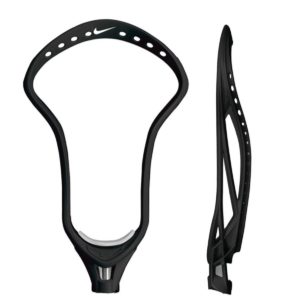
Pros
- Lightweight
- Tight face shape for accurate shots and superior hold
- Flexible and good for faceoffs
- Legal for all levels of play
Cons
- Only 17 sidewall holes, less than most elite heads
- A bit expensive
- Flexibility means it may be prone to warping
Despite not having nearly as wide an array of lacrosse products as other manufacturers on this list, Nike has been responsible for producing one of the most popular lacrosse heads of all time in the Nike CEO. This updated version stays pretty faithful to the original, and should remain popular among its original fanbase: lacrosse midfielders who take a lot of faceoffs ad like to play offense.
The Nike CEO 2, like its predecessor, stands out on this list for have a tight face shape, compared to some of the wider heads like the Warrior Evo 5 and the StringKing Mark 2V.
The tight face shape and narrow scoop may be challenging for some to handle, since it makes catching passes and scooping ground balls a bit more difficult. But for the midfielder who loves to play offense and snipe shots with pinpoint accuracy, the benefits should definitely make up for the drawbacks.
The narrow face shape on this lacrosse head also contributes to its popularity among faceoff middies, since it helps to pinch the ball. But even for those who don’t take faceoffs, that ability to pinch the ball is going to make it much easier to retain possession while dodging and taking stick checks from the defense, both in the midfield and around the goal.
The other drawback is that this head didn’t quite keep up with the stringing arms race amongst lacrosse heads, featuring only 17 string holes. However, if that’s sufficient for you–as it will be for many–this is a great offensive middie head.
Buying Options
FAQs
The Warrior Evo 5 is one of the best lacrosse midfielder heads due to its all-around versatility. However, player preferences differ widely and what’s best for one player might not be the best for everyone.
Typically, STX is the lacrosse brand that tends to be known for stiffness in its heads. The STX Hammer 900, for instance, is thought to be one of the stiffest lacrosse heads around. For midfielders, the STX Stallion Omega is a good pick for a stiff lacrosse head.
One of the most popular lacrosse heads currently on the market is the Maverik Tactik 2.0. This is due to its overall quality as well as its versatility, which is why it is also a great head specifically for lacrosse midfielders.

